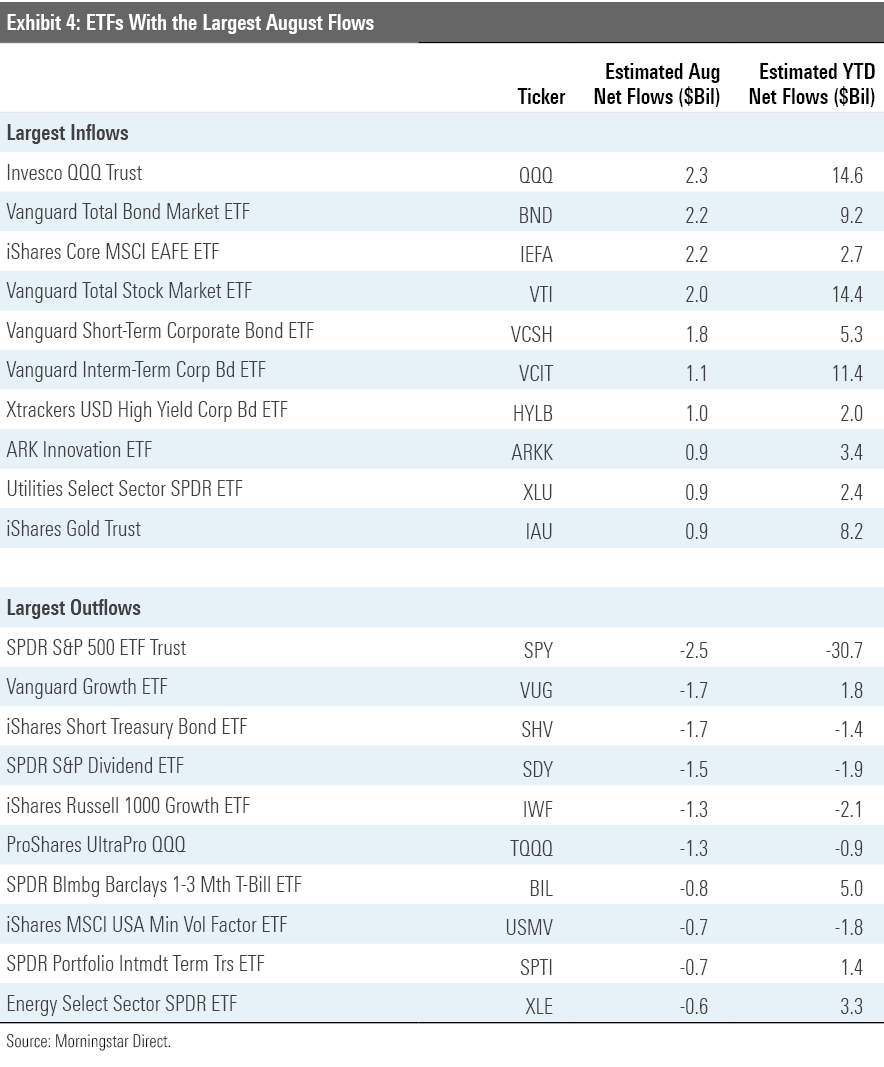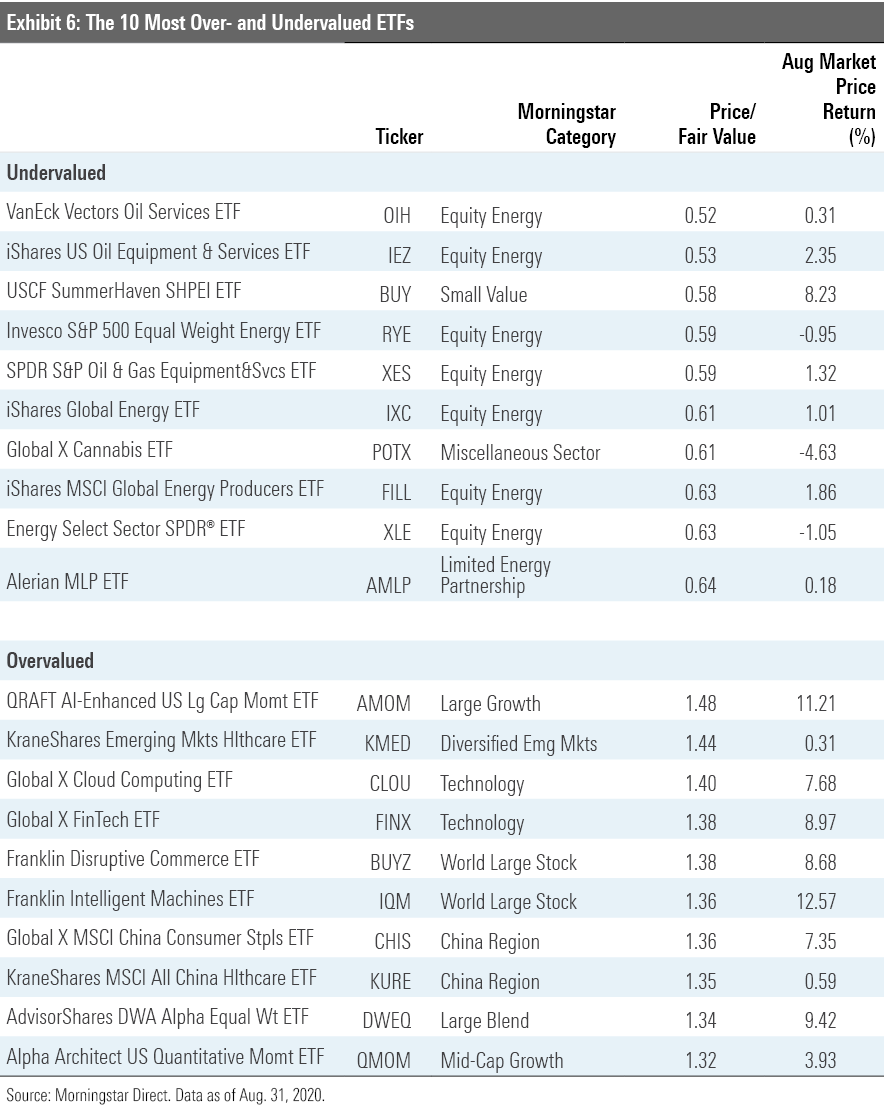Bond ETFs Are on Track for a Banner Year
Investors have piled into fixed-income ETFs in 2020.
Global stocks notched new all-time highs in August 2020. The Morningstar Global Markets Index--a broad gauge of global stock markets--rose 6% during the month. By month-end, the index had rebounded 49% from its late-March low and sat 1.7% above its mid-February peak. The index gained 3.7% through the first eight months of the year. Buoyant stock markets stand in sharp contrast to the lingering economic malaise brought on by the coronavirus.
The Morningstar US Core Bond Index slipped 0.8% in August. Long-term Treasury yields inched higher during the month following the Federal Reserve's announcement of a new policy framework that would allow it to let inflation run above its historical 2% target. This is intended to give the Fed more latitude as it attempts to aid the economic recovery.
Here, I will take a closer look at how the major asset classes performed last month, where investors were putting their money, and which segments of the market look cheap and dear--all through the lens of exchange-traded funds.
After Touching New Highs, U.S. Stocks Look a Bit Rich Exhibit 1 features August performance figures for a sampling of Morningstar Medalist ETFs representing most major asset classes. Investors in a blended global market portfolio gained 3.3% during the month. Stock markets were up across the board. U.S. stocks, as proxied by iShares Core S&P Total U.S. Stock Market ETF ITOT pushed further into overvalued territory, as measured by the fund's Morningstar Price/Fair Value Estimate. Meanwhile, even after making significant gains in recent months, both developed ex-U.S. (represented by iShares Core MSCI EAFE ETF IEFA) and emerging-markets stocks (iShares Core MSCI Emerging Markets ETF IEMG) still look somewhat cheap.

U.S. large caps led the broader market in August. IShares Core S&P 500 ETF IVV outstripped its mid- and small-cap counterparts and finished the month trading at a 7% premium to Morningstar's fair value estimate for its constituent stocks. Much of IVV's monthly gains were driven by its five largest holdings. Apple AAPL, Microsoft MSFT, Amazon.com AMZN, Facebook FB, and Alphabet GOOG jointly accounted for 43% of the fund's August performance. This is not a new development. The S&P 500's largest stocks have been carrying most of the water for a while now, and the index has become increasingly concentrated as a result--recently surpassing levels of concentration last seen at the height of the dot-com bubble.
Growth stocks outpaced value stocks once again in August. The Morningstar US Growth Index gained nearly 10.0%, while the Morningstar US Value Index rose 3.7%. For the year to date, the growth index was up 35.4%, while its value counterpart was down 13.6%. Some investors may finally be crying uncle. ETFs in the large-, mid-, and small-value Morningstar Categories have seen outflows in each of the past five months totaling to $6.8 billion.
The Fed's announcement of its more dovish policy sent long-term interest rates higher and bond prices lower in August. The Fed also wrapped up its bond ETF purchases as of the end of July, so it made no imprint on ETF flows in August. It is still unclear how the Fed will unwind its positions in the ETFs it acquired as part of the Secondary Market Corporate Credit Facility, so it may be some time before it is once again an active participant in the market for fixed-income ETFs.
Strategic-beta ETFs representing a variety of individual factors had a mixed showing versus the broader U.S. stock market. Momentum built a fresh head of steam. IShares Edge MSCI USA Momentum Factor ETF MTUM gained 9.5%, outperforming the broader U.S. market in August. At month's end, MTUM was trading at a 27% premium to its Morningstar fair value estimate. On the other hand, value still looks cheap (it has, unsurprisingly, looked cheap for a while now). IShares Edge MSCI USA Value Factor ETF VLUE was trading at a 15% discount to its Morningstar fair value estimate at the end of August.
Bond ETFs Remain on Track For a Record Year ETF flows have continued to flood bond funds after the Fed put a bid under the market in March. Fixed-income ETFs took in $16.0 billion in net new flows in August, down from July's $29.6 billion and June's $33.5 billion, which marked a monthly record. Over the past five months, estimated net flows into fixed-income ETFs amounted to just over $130.1 billion. This is the largest four-month net flow into bond ETFs on record by a large margin. Bond ETFs are on track to have record inflows in 2020. Through August, they amassed $140.2 billion in net new flows. At this same point in 2019, when bond ETFs raked in a record $156.0 billion in assets, year-to-date flows stood at $97.6 billion.
Within the universe of bond ETFs, Treasury Inflation-Protected Securities ETFs have been particularly popular in recent months. Inflows during each of the past four months rank among the five largest ever for this category. Over that span, inflation-wary investors have added $9.9 billion in new money to these funds--marking nearly 24% organic growth in their assets under management.
Stock ETFs saw modest inflows in August, totaling $11.6 billion. Flows were split across portfolio staples like Vanguard Total Stock Market ETF VTI and iShares Core MSCI EAFE ETF and funds that have experienced searing-hot recent performance like ARK Innovation ETF ARKK and Invesco QQQ Trust QQQ. Notable among the ranks of the stock ETFs with the largest August outflows is iShares MSCI USA Minimum Volatility Factor ETF USMV. This fund has been an investor darling in recent years. Over the three years through February 2020, it hauled in just over $19 billion in net new flows. Over the past five months, investors have yanked nearly $2.2 billion from the fund. Recent performance is likely to blame. While the fund held up well in the sell-off earlier this year, it has missed out on the subsequent rally (as one would expect from this sort of strategy), leaving it 9.5 percentage points behind the Morningstar US Market Index for the year to date through August.



Vanguard's clients have continued to put money to work. The firm's year-to-date ETF flows were slightly greater than the sum of its four largest competitors. At least some portion of Vanguard's ETF flows have resulted from conversions of assets in the firm's Admiral share class to ETF shares, which, following a wave of repricing that was implemented over the past year, are now cheaper than the Admiral shares of the same funds.
Following a three-month streak of outflows that spanned from April to June, Schwab's ETF lineup experienced its second consecutive month of inflows in August. Its three-month drought broke the firm's long record of steady net inflows, which had gone uninterrupted from their 2009 inception through April of this year. Outflows were likely driven by changes to the firm's own proprietary ETF model portfolios.
State Street registered net redemptions in August, as five of its ETFs ranked among the 10 largest by outflows. Flows into SPDR Gold Shares GLD, the world's largest gold-backed exchange-traded product, as well as its Select Sector SPDR suite have been positive. But the firm's crown jewel, the SPDR S&P 500 ETF SPY, has seen $30.7 billion of outflows for the year to date, including $2.5 billion in August.

There's Still Value in Value, but Cloud Valuations Are Sky High The Morningstar fair value estimate for ETFs rolls up our equity analysts' fair value estimates for individual stocks and our quantitative fair value estimates for those stocks not covered by Morningstar analysts into an aggregate fair value estimate for stock ETF portfolios. Dividing this value by the ETFs' market prices yields a price/fair value ratio. This ratio can point to potential bargains and areas of the market where valuations are stretched.
Exhibit 6 features the 10 ETFs that were trading at the largest discounts and premiums to their fair value estimates as of the end of August. Seven of the funds trading at the largest discounts belong to the equity energy category. Pain has been pervasive in the energy sector this year as demand has declined and supply has continued to flood the market. As producers ran out of places to store their output, prices collapsed, as did the share prices of firms operating in the oil- and gas-service industry.
But the market is a discounting mechanism, and just as the oil patch appeared to be on the brink, many investors began wagering that the worst had passed. After a sharp rebound off the bottom, oil prices have normalized, and energy stocks' gains have stalled. Energy Select Sector SPDR ETF XLE, which holds the energy names in the S&P 500, fell 1% in August. While the sector has come back from the edge, many energy names are still trading at steep discounts.
Tech stocks have been on a tear this year, so it is no surprise to see a number of tech-focused funds among the ranks of the most overvalued ETFs. Notable among them are Global X Cloud Computing ETF CLOU and Franklin Disruptive Commerce ETF BUYZ. Both funds were at least 38% overvalued as of the end of August. Investors' enthusiasm for the stocks that these funds own has grown amid a worldwide lockdown that's forced many to work, shop, and live online.

Exhibit 7 features the 10 broad-based ETFs (those belonging to one of the mainline Morningstar Style Box or other broader geographic categories) that were trading at the largest discounts and premiums to their fair value estimates as of month-end. The common thread among the most undervalued funds is an orientation toward smaller, cheaper stocks. Some of them deliberately lean into value by virtue of selecting and weighting stocks based on their relative cheapness. This is the case for Invesco S&P SmallCap 600 Pure Value ETF RZV. There are also four value-oriented funds that invest in international stocks featured on this month's list. Notable among them is iShares Edge MSCI International Value Factor ETF IVLU, the foreign cousin of VLUE, which has a Morningstar Analyst Rating of Silver. Like its U.S. cousin, IVLU takes a sector-neutral approach, sweeping in the cheapest stocks within each sector and weighting them based on a combination of their market cap and the strength of their value characteristics. The result is a portfolio with a strong and consistent value orientation.
The most overvalued broad-based ETFs include a number of funds with a momentum focus. Alpha Architect U.S. Quantitative Momentum ETF QMOM and QRAFT AI-Enhanced U.S. Large Cap Momentum ETF AMOM both spin highly concentrated, high-octane momentum portfolios by design. Folding in names that are priced at premium multiples is embedded in these funds' DNA. KraneShares Emerging Markets Healthcare ETF KMED finished the month trading 44% above its Morningstar fair value estimate. The fund has gained 42% for the year to date.

Disclosure: Morningstar, Inc. licenses indexes to financial institutions as the tracking indexes for investable products, such as exchange-traded funds, sponsored by the financial institution. The license fee for such use is paid by the sponsoring financial institution based mainly on the total assets of the investable product. Please click here for a list of investable products that track or have tracked a Morningstar index. Neither Morningstar, Inc. nor its investment management division markets, sells, or makes any representations regarding the advisability of investing in any investable product that tracks a Morningstar index.

/s3.amazonaws.com/arc-authors/morningstar/a90ba90e-1da2-48a4-98bf-a476620dbff0.jpg)
/d10o6nnig0wrdw.cloudfront.net/04-18-2024/t_34ccafe52c7c46979f1073e515ef92d4_name_file_960x540_1600_v4_.jpg)
/d10o6nnig0wrdw.cloudfront.net/04-09-2024/t_e87d9a06e6904d6f97765a0784117913_name_file_960x540_1600_v4_.jpg)
/cloudfront-us-east-1.images.arcpublishing.com/morningstar/T2LGZCEHBZBJJPPKHO7Y4EEKSM.png)
:quality(80)/s3.amazonaws.com/arc-authors/morningstar/a90ba90e-1da2-48a4-98bf-a476620dbff0.jpg)